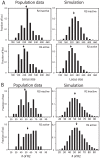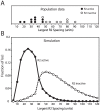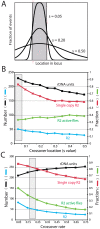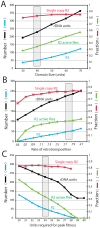A population genetic model for the maintenance of R2 retrotransposons in rRNA gene loci
- PMID: 23326244
- PMCID: PMC3542110
- DOI: 10.1371/journal.pgen.1003179
A population genetic model for the maintenance of R2 retrotransposons in rRNA gene loci
Abstract
R2 retrotransposable elements exclusively insert into the tandemly repeated rRNA genes, the rDNA loci, of their animal hosts. R2 elements form stable long-term associations with their host, in which all individuals in a population contain many potentially active copies, but only a fraction of these individuals show active R2 retrotransposition. Previous studies have found that R2 RNA transcripts are processed from a 28S co-transcript and that the likelihood of R2-inserted units being transcribed is dependent upon their distribution within the rDNA locus. Here we analyze the rDNA locus and R2 elements from nearly 100 R2-active and R2-inactive individuals from natural populations of Drosophila simulans. Along with previous findings concerning the structure and expression of the rDNA loci, these data were incorporated into computer simulations to model the crossover events that give rise to the concerted evolution of the rRNA genes. The simulations that best reproduce the population data assume that only about 40 rDNA units out of the over 200 total units are actively transcribed and that these transcribed units are clustered in a single region of the locus. In the model, the host establishes this transcription domain at each generation in the region with the fewest R2 insertions. Only if the host cannot avoid R2 insertions within this 40-unit domain are R2 elements active in that generation. The simulations also require that most crossover events in the locus occur in the transcription domain in order to explain the empirical observation that R2 elements are seldom duplicated by crossover events. Thus the key to the long-term stability of R2 elements is the stochastic nature of the crossover events within the rDNA locus, and the inevitable expansions and contractions that introduce and remove R2-inserted units from the transcriptionally active domain.
Conflict of interest statement
The authors have declared that no competing interests exist.
Figures







Similar articles
-
Integration, Regulation, and Long-Term Stability of R2 Retrotransposons.Microbiol Spectr. 2015 Apr;3(2):MDNA3-0011-2014. doi: 10.1128/microbiolspec.MDNA3-0011-2014. Microbiol Spectr. 2015. PMID: 26104703 Free PMC article. Review.
-
The pattern of R2 retrotransposon activity in natural populations of Drosophila simulans reflects the dynamic nature of the rDNA locus.PLoS Genet. 2009 Feb;5(2):e1000386. doi: 10.1371/journal.pgen.1000386. Epub 2009 Feb 20. PLoS Genet. 2009. PMID: 19229317 Free PMC article.
-
Rapid R2 retrotransposition leads to the loss of previously inserted copies via large deletions of the rDNA locus.Mol Biol Evol. 2008 Jan;25(1):229-37. doi: 10.1093/molbev/msm250. Epub 2007 Nov 13. Mol Biol Evol. 2008. PMID: 18003600
-
Epigenetic regulation of retrotransposons within the nucleolus of Drosophila.Mol Cell Biol. 2008 Oct;28(20):6452-61. doi: 10.1128/MCB.01015-08. Epub 2008 Aug 4. Mol Cell Biol. 2008. PMID: 18678644 Free PMC article.
-
Evolution of R1 and R2 in the rDNA units of the genus Drosophila.Genetica. 1997;100(1-3):49-61. Genetica. 1997. PMID: 9440258 Review.
Cited by
-
In and out of the rRNA genes: characterization of Pokey elements in the sequenced Daphnia genome.Mob DNA. 2013 Sep 23;4(1):20. doi: 10.1186/1759-8753-4-20. Mob DNA. 2013. PMID: 24059783 Free PMC article.
-
Dead element replicating: degenerate R2 element replication and rDNA genomic turnover in the Bacillus rossius stick insect (Insecta: Phasmida).PLoS One. 2015 Mar 23;10(3):e0121831. doi: 10.1371/journal.pone.0121831. eCollection 2015. PLoS One. 2015. PMID: 25799008 Free PMC article.
-
Causes and Consequences of Varying Transposable Element Activity: An Evolutionary Perspective.Annu Rev Genomics Hum Genet. 2024 Aug;25(1):1-25. doi: 10.1146/annurev-genom-120822-105708. Epub 2024 Aug 6. Annu Rev Genomics Hum Genet. 2024. PMID: 38603565 Free PMC article. Review.
-
Integration, Regulation, and Long-Term Stability of R2 Retrotransposons.Microbiol Spectr. 2015 Apr;3(2):MDNA3-0011-2014. doi: 10.1128/microbiolspec.MDNA3-0011-2014. Microbiol Spectr. 2015. PMID: 26104703 Free PMC article. Review.
-
Preferential occupancy of R2 retroelements on the B chromosomes of the grasshopper Eyprepocnemis plorans.PLoS One. 2014 Mar 14;9(3):e91820. doi: 10.1371/journal.pone.0091820. eCollection 2014. PLoS One. 2014. PMID: 24632855 Free PMC article.
References
-
- Conconi A, Widmer RM, Koller T, Sogo JM (1989) Two different chromatin structures coexist in ribosomal RNA genes throughout the cell cycle. Cell 57: 753–761. - PubMed
-
- Eickbush TH (2002) R2 and Related Site-specific non-LTR Retrotransposons. pp. 813–835. In Mobile DNA II, N. Craig, R. Craigie, M. Gellert, and A Lambowitz, eds. American Society of Microbiology Press. Washington D.C.
Publication types
MeSH terms
Substances
Grants and funding
LinkOut - more resources
Full Text Sources
Other Literature Sources
Molecular Biology Databases

